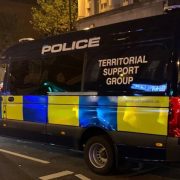A year ago today the East London Line opened from Dalston to New Cross and ELL was there to witness it.
For Goldsmiths staff and students the opening of the first phase was a particular blessing as it re-connected us with the heart of the East End – with its galleries, markets, pubs and restaurants and of course such places as the Truman Brewery.
The line was commissioned originally by then Mayor Ken Livingston but he was not there to see it open, and on that important day party politics rather clouded the celebration.
Jules Pipe, the Labour mayor of Hackney wasn’t even invited to the opening of Hackney’s first tube line. We met him standing outside.
Labour London Assembly member Val Shawcross told the BBC at the time of opening: “It’s a bit rich for Boris Johnson to try and take credit for it in the middle of the election campaign, when it was in fact funded and started by a Labour mayor thanks to Labour government funding.”
His detractors were wary of the rhetoric Mr Johnson used when opening the line, saying: “This type of investment is essential if London, throwing off the shackles of recession, is to emerge with the ability to grow, prosper, and secure its position at the summit of world cities, to the benefit of all Londoners.” His comments came amid worry about the cuts he proposes to make to the entire London Underground network over the next eight years.
Despite the political in-fighting, the line has achieved an excellent service record. In January 2011, it was the most punctual service in the UK, with 96.4 per cent of trains arriving within five minutes of their scheduled time, according to Network Rail. The national average for train punctuality is just 90.3 per cent.
New Rail: Old Technology
However it hasn’t all gone smoothly. The winter of 2010/11 gave the redeveloped line a serious trial. The rail service was temporarily crippled by the bad weather, with the freezing temperatures grinding services to a halt for several hours on several occasions. We saw trains stranded at Crystal Palace while all the lines between Dalston and New Cross were empty of trains, but completely clear of snow.
There are several reasons for the failure. For starters, the technology used on the line is historically a major casualty of cold weather. The “third rail system”, which electrifies the train from underneath, is prone to being so cold that snow freezes onto it immediately upon contact.
This provides a layer of insulation between the train’s power-shoe and the rail and can result in electricity “arcing”, which damages trains and poses danger to passengers. The technology used was developed in the 1930s when it was favoured for being much cheaper than erecting overhead power lines.
A TfL spokesman for the East London Line and Overground network, explained that when the redevelopment was started, there was a significant section of “third-rail-electrified track” in place, and it was “more cost effective” to continue the use of the technology.
When the first disastrous days of delay had passed, TfL announced: “Stocks of de-icing fluids have been topped up and [London Overground] have put cold weather plans into place to deal with the possible impacts of ice and snow on the network.” Too little, too late. And just why do we have to rely on this old technology on a brand new line?
A Technological Fix
The problem may well be solved, though, thanks to technology currently being pioneered by Network Rail. They have enlisted the services of a company called Eltherm, which manufactures industrial heat conducting equipment, and has specially designed a heated strip that can be attached to the tracks of any rail network. The system, called El-Rail, comprises strips of insulated heat conductors, which can be clipped onto the third rail by hand.
It feeds off the same power supply, but will ideally be controlled by panels that can be operated according to forecasts; the residual temperature of a freezing third rail would take too long to heat up from below zero degrees according to a thermostat response. Additionally, the ease of attachment means that operators do not have to close large sections of the line for very long as the technology can be installed at night when trains are no longer running.
National Rail is piloting the system in Kent, where it has already installed 16,000 meters of the heating strips to the third rails on Kent routes. Dave Ward, Network Rail’s route director for Kent, said:
“We have analysed weather patterns over the last ten years to identify the most vulnerable areas and it is here that we are concentrating the trial of the heating strips.”
Network Rail is planning to extend the use of the system to East and West Sussex, Surrey and Hampshire in the near future
East London Line Ownership Chaos
A spokesman for TfL said the implementation of the technology on the East London Lines is complicated by the ownership of the Overground system.
The East London line itself is owned by TfL, which subcontracts the management of the line to Network Rail; but south of New Cross Gate, the track is owned and operated by Network Rail. And this is where the ambiguity lies.
So far in its operation, the problem of ice building up on the conductor rail has not been significant enough to cause any trains to stop operating on TfL’s stretch of the line. The problem stemmed from the section of the line owned by Network Rail, and over which TfL exercises no power.
Additionally, the Overground line is shared between several train operators including Southern and TfL’s East London Line trains. Hold-ups and delays can be caused by trains from the other operators breaking down on the same stretch of track that TfL uses, thereby delaying their trains through no fault of their own.
Unfortunately, TfL can only install the heating technology on the section of the rail it owns – but since their section didn’t suffer from ice build-up, they do not have plans to install the heating system. The rest of the Overground line (and therefore the piece owned by Network Rail) is not the subject of any talk about installing the heating system. The trial schemes for the technology don’t even touch London’s local lines so far.
ELL spoke to a member of Overground staff at Canada Water station, who asked to remain anonymous. He said that engineers had been deployed in extra numbers to make sure that the third rail was kept in as operable a condition as possible, but that many of them knew the task was enormous. “When the temperature drops quickly outside, then rain or snow just freezes straight away and without warning – you can’t predict it.”
So, while it is true that the overall punctuality of the new service is second to none in the UK – passengers can still look forward to days without any service if the temperature drops below freezing again. Unless, of course, the various owners of the different bits of the line and the rolling stock get together and work out a solution.
It’s a pity the Olympics are not happening in December. It seems to be the only event capable of getting different factions to sit around a table to sort things out. As the numbers using the new line steadily increase there will be a lot less patience with excuses about the wrong sort of temperatures.
We have the technology – lets use it.







“This provides a layer of insulation between the train’s power-shoe and the rail and can result in electricity “arcing”, which damages trains and poses danger to passengers. The technology used was developed in the 1930s when it was favoured for being much cheaper than erecting overhead power lines.”
Codswallop! Any damage to conductor shoes from arcing will be insignificant compared with the normal wear and tear from friction with the conductor rail and detritus that get between the shoe and the rail. There is no danger whatsoever to passengers. Third rail electrification has been in use around the world since the 1880s.
In tunnels and built up areas with lots of bridges there may simply not be enough height to install overhead power lines.
We bow to your obviously greater knowledge – thanks for commenting!
No need to bow – enough of that malarky this week as it is, but feel free to buy me a pint the next time you are in the Dog.